AMD's Radeon HD 6790: Coming Up Short At $150
by Ryan Smith on April 5, 2011 12:01 AM ESTPower, Temperature, & Noise
Last but not least as always is our look at the power consumption, temperatures, and acoustics of the Radeon HD 6790. Our power usage data should closely mirror any other 6790, but given the unique design of our card versus what AMD’s partners are going with, we can’t fully account for all the different designs.
On that note, at this point we do not know what the 6790’s default voltage is. None of our usual low-level tools recognize the 6790; it’s possible that AMD is using different controllers than on the 6800 series, or perhaps it’s related to drivers. In any case we believe it’s close to the 6870’s voltage of 1.17v, but we can’t measure it at this time.
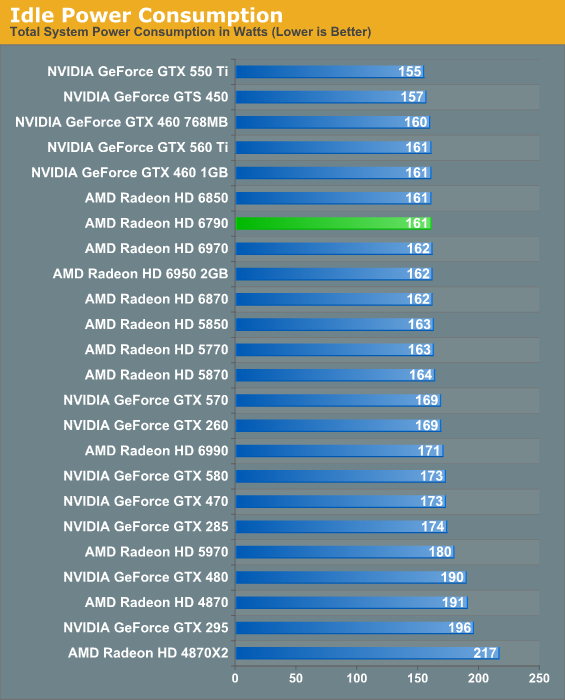
Idle power consumption rarely changes among the different tiers of a GPU, so the fact that the 6790 pulls almost as much power at idle as the 6800 series should not come as a surprise. It does end up being worse than the GTX 550 Ti, but almost exactly alike the GTX 460.
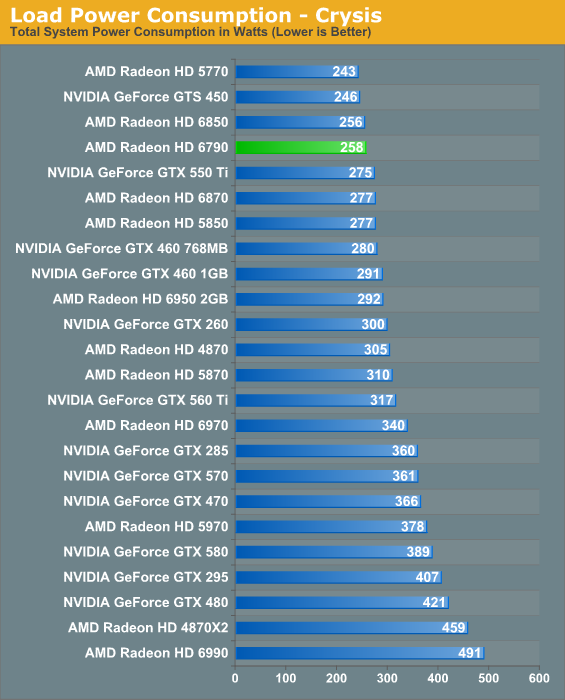
Given AMD’s TDP numbers, we were expecting our power results to closely shadow our 6870 results. Instead we had a pleasant surprise: power consumption under Crysis is higher than the 6850, but not significantly so. In fact it’s still below the GTX 550 Ti even though it significantly outperforms said video card on this game, and even compared to the 5770 it’s not significantly worse for the 6790’s performance advantage. Not that it’s great to be consuming more power than a 6850 for less performance, but it could very well have been worse.
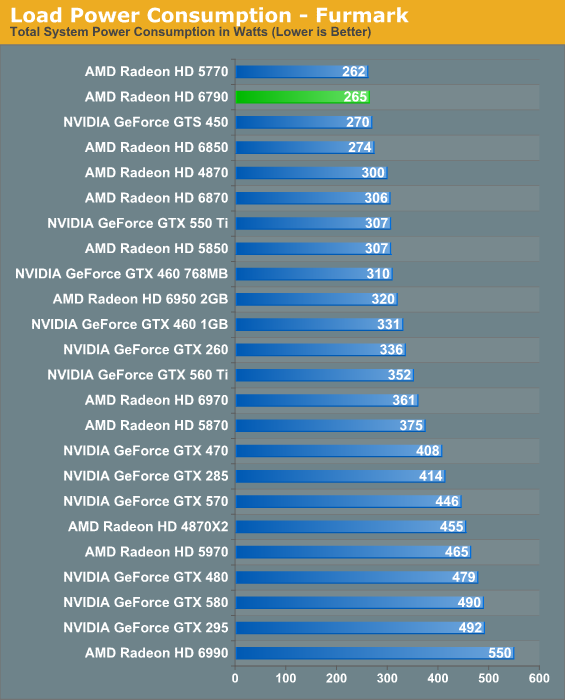
The situation under Furmark is even better surprisingly enough. The 6790 consumes less power than the 6850 here – not a ton less, but less. Perhaps more surprising is that compared to the 5770 it’s only consuming 3W more; this Barts chip may have a lot of functional units disabled, but that’s still quite remarkable, and is all the more proof of the optimizations AMD made for Barts compared to Cypress. This also makes it look exceptionally good versus the GTX 550 Ti and GTX 460 768MB, as it’s consuming 40-45W less.

With idle power consumption being identical to the 6800 series and using the same cooler, the idle temperature is similarly close.
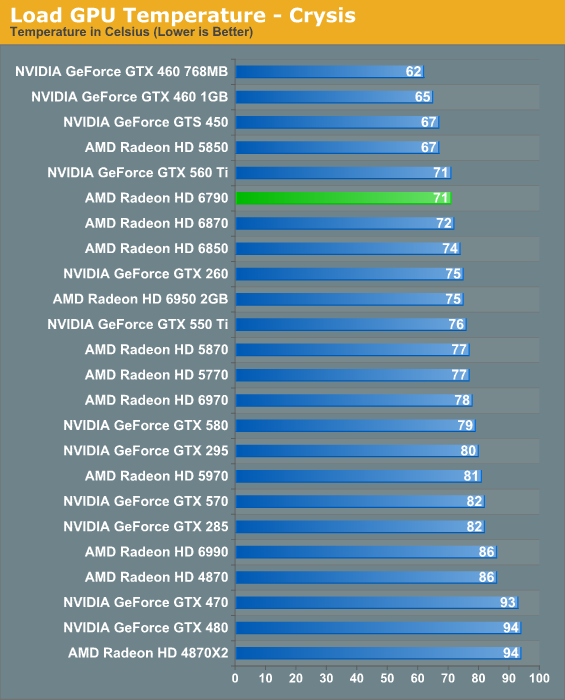
Given the power numbers we saw earlier, the 6870’s cooler ends up being overkill for the 6790. As a result Crysis temperatures are quite low, although the fully exhausting cooler can’t keep up with the open cooler of the GTX 460. Then again our 5770 is an open cooler, and it’s still much warmer. Keep in mind that this is going to highly vary with the design of the cooler the partner uses though.
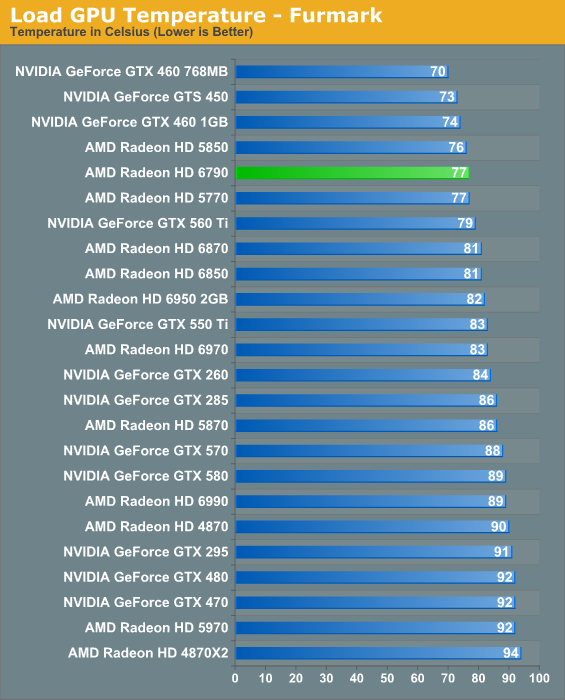
Temperatures under Furmark closely trend Crysis. An open cooler might be able to get the 6790 down to the low 70s.
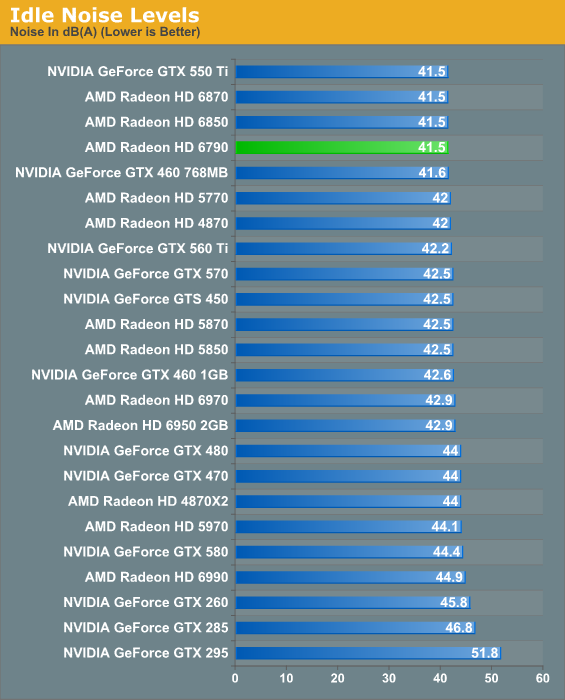
Idle noise is identical to the 6800 series, as we’d expect.
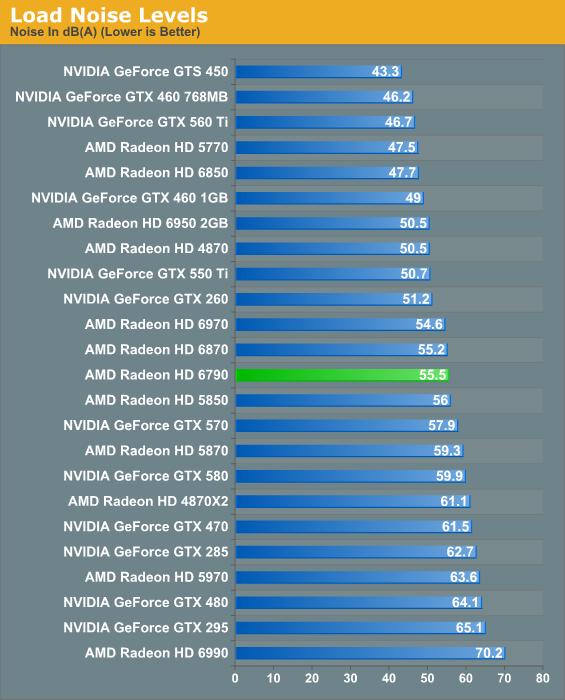
Load noise is where the wheels begin to fall off on our 6790 sample. The card does so well with regards to power consumption and temperature, but noise is just as bad as the 6870. This undoubtedly is due to how AMD tweaked the 6790 engineering sample – which is to say it likely hasn’t been optimized much if at all since it won’t go into production. Given the power data we’ve seen the 6790 doesn’t need to be much louder than a 6850, so hopefully partner cards will reflect this. If not, the worst case scenario may very well be having all the noise of a 6870 and not nearly the performance.










69 Comments
View All Comments
silverblue - Tuesday, April 5, 2011 - link
Until we shift from 40nm, probably.mgl888 - Tuesday, April 5, 2011 - link
Not much they can do without a process shrink. Architectural improvements can only go so far.Taft12 - Tuesday, April 5, 2011 - link
No, there is no wall to speak of. The 4870 was a "first tier" part and this 6790 is "third tier". Compare the performance of the 4870 with a 6970 instead (and indeed the launch price of the 4870 with the launch price of the 6970) and you'll see we are doing just fine thank you very much.tno - Tuesday, April 5, 2011 - link
But not long after release the 4890 was retailing after discounts for $160-150. That's what I bought mine at and I have yet to find a compelling card to take its place. Part of that does have to do with a decrease in my gaming, but if I was a budget gamer, I would look long and hard at a used 4890.tno - Tuesday, April 5, 2011 - link
+1pandemonium - Wednesday, April 6, 2011 - link
Only if you don't consider the broad picture and are looking at performance individually.marc1000 - Tuesday, April 5, 2011 - link
I have a 5770. and even with the desire to upgrade to 6950/gtx570, i try to remain honest with me and tell to myself: "I don't need it"this level of performance if perfectly fine to play all current games, because we are all stuck with console ports...
jordanclock - Tuesday, April 5, 2011 - link
I have a 5770 as well, and at 1680x1050, almost everything runs flawlessly, even with AA at 2x or 4x. The situation with multiplatform development is starting to really agitate PC gamers, I think. Crysis 2 looks infinitely better on PC (And ultra high end setups run tri-monitor quite well!), Dragon Age 2 has a texture pack that consoles wouldn't even have the memory to use, and so many games are looking identical on PC and console, meaning that while they run at high framerates on modest hardware, there is no option to increase visual fidelity to offset the increased hardware.tno - Tuesday, April 5, 2011 - link
I concur. I have a 4890 that I picked up for $160 not long after its release after discounts. This thing was top tier, and it was pretty unique product coming out when ATI started treating their multi-GPU single card solutions as their true halo products. And for its flaws (noisy, power hungry and no DX11) it competes for performance at its original price.This is mirrored, frankly, in the PC market where the effective performance increase, that is performance that the average PC user (not us) will notice, has remained fairly flat since Conroe. What has improved is features. For that same budget dual-core Conroe price you get an integrated GPU worth its salt, improved efficiency, improved encoding/decoding performance (the thing users might notice most) and, possibly, more cores.
kmmatney - Tuesday, April 5, 2011 - link
I also have a HD4890, bought for $170, and attached an Accelero S1 cooler, so its virtually silent (only a very slow spinning fan that I can't hear across the heatsink). I'm still amazed after so much time that I cannot get a better card for the same price - things just haven't progressed much in the bang-for-buck department.